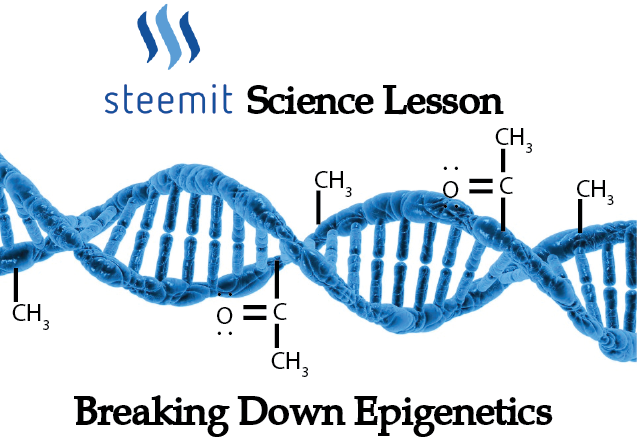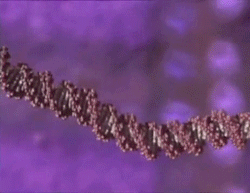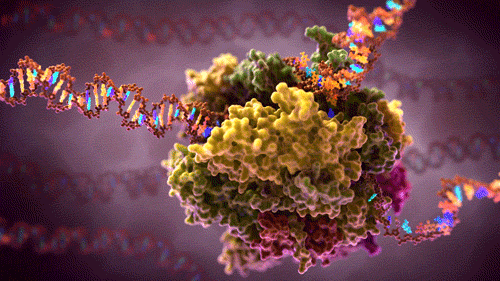
Preface
Earlier this week I had a discussion with user @laymanave who suggested I take the time to write out some background information on epigenetics. I thought this was a great idea as epigenetics is a hot topic in biological research right now, and as one of the frontiers of science there are a lot of very exciting discoveries being made. What better time then now to increase our understanding of this secondary layer of information storage and regulation in our genetic code. So with out further adieu let us begin!
As a site note (for the biologists/biochemists who shook their head at the title image!): The title image is just for fun and shows off the types of functional groups involved in epigenetic regulation; DNA itself is not acetylated (well not that we know of at least!).
DNA and Genes
In previous science lesson posts (Part 1, Part 2, and Part 3) we discussed what DNA was, how it is replicated, genes, and how the cell utilizes those genes to make proteins. In essence these posts described the mechanism by which a cell stores information, and then utilizes that stored information as a blueprint to create molecular machines (proteins) which perform a specific chemical function for the cell.
In a separate and later science lesson post (Part 6) we discussed the massive amount of DNA present inside a cell, and the mechanisms by which cells compact that DNA into cells. We talked about chromatin (the compacted DNA) as well as the nucleosomes (composed of protein complexes called histones that spool up DNA and aide in it compacting tightly together into chromatin, the material that makes up our chromosomes).
For quite some time (decades really) the scientific community thought that was the full story, but as research continued they found discrepancies in the amounts of certain proteins that cells expressed. They also noticed differences in cellular inheritance of genes that could not be explained by simple Mendelian inheritance. There had to be more to the story of genetic regulation. The missing piece was found to be chemical modifications to the histone proteins in the nucleosome particles of chromatin, as well as direct chemical modifications of the DNA itself. These modifications result in a change in phenotype (outward appearance) while maintaining the same genotype (genes and their organization in the genome). We refer to these modifications and all of the effects that these modifications have on the expression of genes as epigenetics. The prefix epi- in Greek means upon or over, which is exactly what this regulation is, a layer on top of the genetic layer.
What Are These Modifications?
Generally epigenetic modification involves the attachment of two different chemical groups: one called a methyl group (-CH3), and another called an acetyl group (-COCH3). These modifications are generally added to two locations, on the flexible tails of the histone proteins in the nucleosome complex, or on the DNA base cytosine. It is important to know that epigenetic modifications are not permanent, they can be added, removed, and re-added again as the cell needs or as environmental factors dictate. It is this aspect that makes epigenetic regulation so fascinating. The methylation (addition of a methyl group) or acetylation (addition of an acetyl group) can turn genes on, off, or result in any variety of increased or decreased production levels depending on where they are added in a gene. These modifications are part of what make us who WE are. Our life's experiences can change our epigenetic methylation and acetylation patterns, they change as we grow and develop and we are only just beginning to scratch the surface of what it all CAN mean for the functioning of our cells.
Modification of Histone Proteins Change Tightness of DNA Packing
Let us begin with the first class of epigenetic modification, methylation of histone tails. As we discussed above, and in a previous post, the histone octamer is an eight protein complex (comprised of two copies each of four separate proteins H2A, H2B, H3 and H4) upon which DNA spools around.

The tightness upon which DNA is spooled determines (in part) whether genes contained in it are is available for an RNA polymerase to come in and synthesize mRNA (the first step leading to creation of a protein from a gene!).

If the DNA is spooled too tightly then it is not accessible, but if it is spooled too loosely then the DNA can not be effectively compacted into chromatin and subsequently into our chromosomes! So a mechanism must exist that regulates the compaction of DNA on the histones in these nucleosome complexes.
That mechanism is attachment of a (-CH3) aka methylation
Figure : Methylation of Histone Tails

The figure above is a x-ray crystal structure of a nucleosome complex, you can see the histones in the center of the complex, each with a separate color and wrapped around that histone complex is DNA. If you will notice there are little strings of protein that extend outward away from the DNA, these are called the histone tails. It is on these histone tails that the epigenetic modification of methylation occurs (in the figure I have added some stars to show you where this is happening). The methylation can occur on any Lysine or Arganine amino acid in the tails of any histone, however commonly is found to occur on specifically on the tails of 2 histones (H3 and H4). Methylation at arginine residues (a residue is an amino acid constituent in a protein chain) is accomplished through the workings of a protein called "protein arginine methyltransferase" or PRMT. PRMT can transfer a methyl group to any free arginine residue in a protein, while methylation at a histone lysine residue requires the function of a different protein called histone methyl transferase or HMT. HMT unlike PRMT only functions to place these methyl groups on the histone tails.
Above we discussed that DNA compaction needs to be regulated, and that this compaction process involves methylation. Much like all biological processes methylation occurs at very specific sites, and different sites confer different properties. For instance research has illustrated that methylation on a specific lysine residue (K20) in the tail of the H4 histone results in tight compaction of the DNA around the histones. (Source) This results in genes located in the DNA on that histone are in a repressed state (as we mentioned above, tightly packed DNA means RNA can't be made, the repressed state refers to a reduced amount of protein being made).
Methylation Is Not Just For DNA Compaction
Lysine residues can actually have more than one methyl group added to them. Knowing anything about biology (and you should be getting to know a lot more if you have been reading my blog!) you might already have an idea what I am going to tell you. The addition of additional methyl groups result in a totally different result! While the addition of one methyl to H4 lysine K20 makes the DNA more compact and represses gene expression, a second methyl group can be added to that same lysine residue if the DNA wrapped around the histones was to get damaged and broken. The second methylation event actually signals to the cell that it needs to get the DNA double strand break repair machinery the hell over there and seal that break up. (Source).
Okay... Histone Methylation Regulates DNA Compaction, Gene Expression, and DNA Damage... Didn't You Mention Something About Acetylation As Well?
Damn, you're sharp as a tack! You don't let me slide on anything do you!? Good on you for paying such close attention. So acetylation is a bit different from methylation, it isn't added to cause an effect. It's kept in a state of rapid equilibrium being added by an enzyme called histone acetyltransferase (HAT) and removed by a different enzyme called histone deacetylase (HDA). The acetylation of the histones usually occurs (as with methylation) on histones H3 and H4. The acetylation/deacetylation state of these two histone tails is involved in a variety of cellular processes including but not limited to gene silencing, the progression of the cell cycle, programmed cell death (apoptosis aka the cell killing itself), DNA replication and DNA repair. Destabilization of the acetylation/deacetylation equilibrium whether due to compounds which inhibit one of the two enzymes involved (HAT or HDA), or mutations in the genes that encode for those enzymes have been shown to lead to the development of cancer. (Source. The fact that this breaking this tightly regulated and incredibly cellularly involved process can lead to cancer should come as little surprise to you!
Conclusions and The Next Installment
So there you have it, we have begun to discuss the background information for giving you some insights into epigenetics. An extra layer of complexity on-top of the already complex nature of our genetic material, that is involved in controlling how the DNA is stored in cells, and how much of a protein is able to be expressed by the cell (AND SO MUCH MORE). I hope that this post has provided you with at least a bit more clarity, and I can promise you that we are FAR from done. If you stick with me in this short series we will dive further into direct DNA methylation of the DNA base cytosine, and then use our newly established understanding to look at some of the more recent findings as to what these epigenetic modifications are specifically DOING for the cell as well as how these transient modifications may actually be passed on from parent to offspring.
References
- https://en.wikipedia.org/wiki/Epigenetics
- https://steemit.com/science/@justtryme90/science-lesson-dna-part-1
- https://steemit.com/science/@justtryme90/science-lesson-dna-part-2-dna-replication
- https://steemit.com/science/@justtryme90/science-lesson-dna-part-3-how-does-the-cell-get-information-out-of-dna
- https://steemit.com/biology/@justtryme90/science-lesson-dna-part-6-how-does-dna-fit-in-the-cell
- https://en.wikipedia.org/wiki/Histone_methylation
- http://www.whatisepigenetics.com/fundamentals/
- https://www.ncbi.nlm.nih.gov/pubmed/28082740
- https://www.ncbi.nlm.nih.gov/pubmed/18552846
- http://www.whatisepigenetics.com/histone-modifications/
- https://www.ncbi.nlm.nih.gov/pubmed/10322142
All non Cited Images Are From Flickr.com and Are Available Under Creative Commons Licenses
All Gifs Are From Giphy.com and Are Also Available for Use Under Creative Commons Licences
If you like my work, please consider giving me a follow: @justtryme90. I am a PhD holding biochemist with a love for science. My future science blog posts will cover a range of topics in the biology/chemistry fields.
Thank you for your continued support of my work! I appreciate all those who follow me (and those who don't too).
Terrific post. Very educational and easy to follow. Thank you!
Thanks for reading @donkeypong! Much appreciated
The way I look at it is...
We are all dealt a hand of cards genetically. More cards than we could ever use...
Then our environment, choices and trajectory determine to an extent which cards are played, which ones are held and which are discarded.
Its a use it or loose it scenario.
Indeed that is an apt line of thought. Thanks for reading and commenting @gavvet.
Magnificent post: the choice of pictures and animated graphics are showing off the meaning of the whole write-up so clearly. Great job, thanks a bunch for the education, upvoted, followed and namaste :)
Thank you for reading, and your compliments. I am glad you enjoyed the post!
Great post! Resteemed. I was planning on doing one, but not as scientific,a nd related to psychological epi-genetic influence. Environment affects the physical as well as psychological domain, and the psychological affects the physical and vice versa hehe.
You should go into that! I will stick to the biochemistry :)
Thank you for the kind words @krnel, I appreciate it!
stupid fucking shill account
Me? No I am a regular person.
Great post i use to study chemistry long ago..is that true that somehow we have the ability to "re-write" our own DNA ?
Re-writing implies that the underlying genetic code is changeable, which is not naturally possible. However from an epigenetic perspetive the body can regulate gene expression (this through methylation, and in my next post on this I am going further into actual DNA methylation itself as a means to regulate how much of a gene is actually turned into a protein). So our epigenetic methylation states can be "re-written" thus the amount of proteins produced could be changed.
Does this at least begin to answer your question? Maybe if it is on the right track then maybe my next post in this series will help explain a bit better!
Yes, your answer is clear and confirm my thoughts.....our body is like a soup , even with the same ingredients (food, air, water) that we bring inside, the result will be different for every person, then our level of energy, how we control it, will be a key factor in our abilities to alter our DNA for a better one.
Another question : How water can influence our DNA, as our body is 72% of water ?
I don't have a direct answer for that one. There are a lot of pathways that could be influenced by too much or two little water which could influence these regulatory pathways. However directly water itself has no real interplay other than serving as the solvent which DNA is dissolved in.
Thanks for your answer, ..interesting....so is the quality of the solvent important ?.
Water has memory, it's very intelligent itself, they way we look at it, the thought, how we handle it , anyway it's another story.
I appreciate meeting with people like you , thanks to Steemit, i can find great people to discuss, so i m happy.
Water doesn't have memory...
Great post as usual. I always found genetics to be an awesome topic. Lamarckian genetics is now somewhat valid! It also gives us more motivation to live healthier lives because the children or grandchildren (more often) could suffer the consequences.
Thank you very much @tfeldman, I appreciate your read and comment!
Wow - what a post :-)
Thank you very much :)
Edit: Usual grammar corrections. Added a sentence describing the greek prefix epi- in epigenetics.